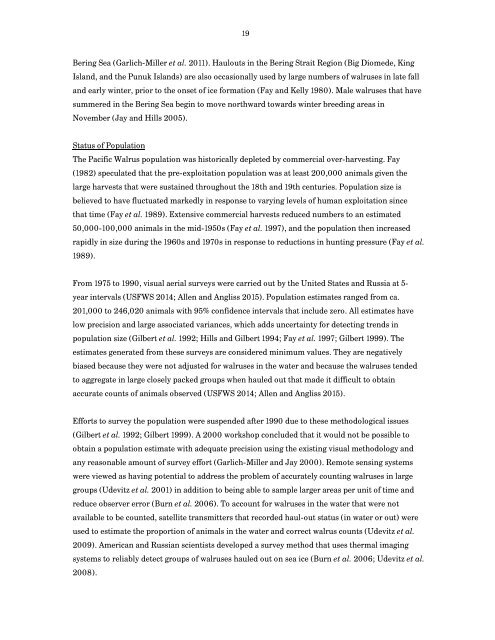The State of Circumpolar Walrus Populations
walrusreport
walrusreport
You also want an ePaper? Increase the reach of your titles
YUMPU automatically turns print PDFs into web optimized ePapers that Google loves.
19<br />
Bering Sea (Garlich-Miller et al. 2011). Haulouts in the Bering Strait Region (Big Diomede, King<br />
Island, and the Punuk Islands) are also occasionally used by large numbers <strong>of</strong> walruses in late fall<br />
and early winter, prior to the onset <strong>of</strong> ice formation (Fay and Kelly 1980). Male walruses that have<br />
summered in the Bering Sea begin to move northward towards winter breeding areas in<br />
November (Jay and Hills 2005).<br />
Status <strong>of</strong> Population<br />
<strong>The</strong> Pacific <strong>Walrus</strong> population was historically depleted by commercial over-harvesting. Fay<br />
(1982) speculated that the pre-exploitation population was at least 200,000 animals given the<br />
large harvests that were sustained throughout the 18th and 19th centuries. Population size is<br />
believed to have fluctuated markedly in response to varying levels <strong>of</strong> human exploitation since<br />
that time (Fay et al. 1989). Extensive commercial harvests reduced numbers to an estimated<br />
50,000-100,000 animals in the mid-1950s (Fay et al. 1997), and the population then increased<br />
rapidly in size during the 1960s and 1970s in response to reductions in hunting pressure (Fay et al.<br />
1989).<br />
From 1975 to 1990, visual aerial surveys were carried out by the United <strong>State</strong>s and Russia at 5-<br />
year intervals (USFWS 2014; Allen and Angliss 2015). Population estimates ranged from ca.<br />
201,000 to 246,020 animals with 95% confidence intervals that include zero. All estimates have<br />
low precision and large associated variances, which adds uncertainty for detecting trends in<br />
population size (Gilbert et al. 1992; Hills and Gilbert 1994; Fay et al. 1997; Gilbert 1999). <strong>The</strong><br />
estimates generated from these surveys are considered minimum values. <strong>The</strong>y are negatively<br />
biased because they were not adjusted for walruses in the water and because the walruses tended<br />
to aggregate in large closely packed groups when hauled out that made it difficult to obtain<br />
accurate counts <strong>of</strong> animals observed (USFWS 2014; Allen and Angliss 2015).<br />
Efforts to survey the population were suspended after 1990 due to these methodological issues<br />
(Gilbert et al. 1992; Gilbert 1999). A 2000 workshop concluded that it would not be possible to<br />
obtain a population estimate with adequate precision using the existing visual methodology and<br />
any reasonable amount <strong>of</strong> survey effort (Garlich-Miller and Jay 2000). Remote sensing systems<br />
were viewed as having potential to address the problem <strong>of</strong> accurately counting walruses in large<br />
groups (Udevitz et al. 2001) in addition to being able to sample larger areas per unit <strong>of</strong> time and<br />
reduce observer error (Burn et al. 2006). To account for walruses in the water that were not<br />
available to be counted, satellite transmitters that recorded haul-out status (in water or out) were<br />
used to estimate the proportion <strong>of</strong> animals in the water and correct walrus counts (Udevitz et al.<br />
2009). American and Russian scientists developed a survey method that uses thermal imaging<br />
systems to reliably detect groups <strong>of</strong> walruses hauled out on sea ice (Burn et al. 2006; Udevitz et al.<br />
2008).


